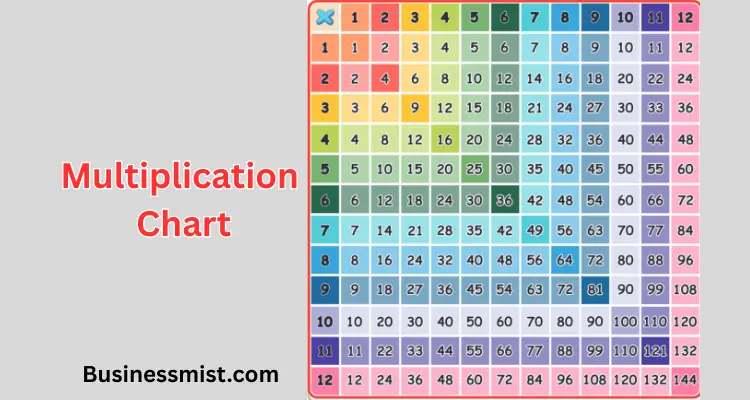Multiplication Chart: Benefits, Ranges, Easy Ways to Learn

Did you know that learning a multiplication chart can help kids solve math problems up to 10 times faster? A multiplication chart is a simple tool that makes math easier, and this article will show you everything about it, from what it is to how it helps students and even adults.
I’ll walk you through the details, share a real story, and give you practical tips to master multiplication charts like the multiplication chart 1 through 100 or a printable multiplication chart. Whether you’re a parent, teacher, or learner, let’s dive into this handy math tool together!
What Is a Multiplication Chart?
A multiplication chart is a table that shows the product of two numbers, often called a times table. It’s a grid where one set of numbers sits on the left column and another on the top row, with each box showing the result of multiplying those numbers.
This chart of multiplication tables saves time and energy by giving quick answers without heavy calculations. A multiplication chart pdf is also available for free download, making it easy to print and use. Teachers and parents love it because it helps kids grasp multiplication early on.
Exploring the Multiplication Chart 1-100
The multiplication chart 1 through 100 covers times tables from 1 to 20, offering a full range for learning. Let’s break it down by ranges to make it clear:
Multiplication Chart 1 to 10
The times table chart 1 to 10 lists numbers 1 to 10 on the top row and left column. Each box shows the product, like 2 × 3 = 6 or 5 × 4 = 20. You can find detailed tables for each number, such as the multiplication table of 2 or multiplication table of 5, on separate pages.
Multiplication Tables 2 to 5
2. Times Table: 2 × 1 = 2, 2 × 2 = 4, up to 2 × 10 = 20.
3. Times Table: 3 × 1 = 3, 3 × 2 = 6, up to 3 × 10 = 30.
4. Times Table: 4 × 1 = 4, 4 × 2 = 8, up to 4 × 10 = 40.
5. Times Table: 5 × 1 = 5, 5 × 2 = 10, up to 5 × 10 = 50.
Maths Tables 6 to 10
6. Times Table: 6 × 1 = 6, 6 × 2 = 12, up to 6 × 10 = 60.
7. Times Table: 7 × 1 = 7, 7 × 2 = 14, up to 7 × 10 = 70.
8. Times Table: 8 × 1 = 8, 8 × 2 = 16, up to 8 × 10 = 80.
9. Times Table: 9 × 1 = 9, 9 × 2 = 18, up to 9 × 10 = 90.
10. Times Table: 10 × 1 = 10, 10 × 2 = 20, up to 10 × 10 = 100.
Times Tables 11 to 15
11. Times Table: 11 × 1 = 11, 11 × 2 = 22, up to 11 × 10 = 110.
12. Times Table: 12 × 1 = 12, 12 × 2 = 24, up to 12 × 10 = 120.
13. Times Table: 13 × 1 = 13, 13 × 2 = 26, up to 13 × 10 = 130.
14. Times Table: 14 × 1 = 14, 14 × 2 = 28, up to 14 × 10 = 140.
15. Times Table: 15 × 1 = 15, 15 × 2 = 30, up to 15 × 10 = 150.
Times Tables 16 to 20
16. Times Table: 16 × 1 = 16, 16 × 2 = 32, up to 16 × 10 = 160.
17. Times Table: 17 × 1 = 17, 17 × 2 = 34, up to 17 × 10 = 170.
18. Times Table: 18 × 1 = 18, 18 × 2 = 36, up to 18 × 10 = 180.
19. Times Table: 19 × 1 = 19, 19 × 2 = 38, up to 19 × 10 = 190.
20. Times Table: 20 × 1 = 20, 20 × 2 = 40, up to 20 × 10 = 200.
These charts for multiplication give a clear view of how numbers multiply, making it a multiplication chart 1-100 resource.
Benefits of Using a Multiplication Chart
A multiplication chart brings lots of advantages for students and learners. Math’s tables support the mathematical learning of a student and give them a strong grasp of multiplication facts They make it easier to work out problems in mathematics and reduce mistakes with exact computations. Students who know their multiplication charts tend to feel more self-assured when learning new math concepts.
Plus, recognizing patterns in a chart helps kids understand numbers and find prime numbers. A blank multiplication chart or empty multiplication charts lets kids fill in answers, boosting their practice. These free printable multiplication table options also help with quick solutions to problems involving fractions, percentages, and factoring.
How to Read and Use a Multiplication Chart
Reading a multiplication chart might seem hard at first, but it’s simple with practice. Locate the numbers you want to multiply on the left side (rows) and top (columns) of the chart. Find where the row and column meet to get the product, like 7 × 8 = 56. A multiplication chart’s goal is to provide a quick reference, eliminating the need for mental math and helping kids learn easily. Place a printable multiplication table somewhere visible to memorize it faster. This visual aid is common in primary schools to help pupils retain multiplication facts.

Multiplication Charts for Different Ranges
Different ranges of multiplication charts serve various needs. The multiplication table 1 to 10 is perfect for beginners, while the multiplication tables from 1 to 20 support multi-digit calculations. A multiple chart or chart of multiplication tables up to 20 helps with mental arithmetic and complex problems.
You can download a multiplication chart pdf for any range to print and use anytime. These tools are essential building blocks for higher math like exponents.
Easy Ways to Learn Multiplication Charts
Students often find memorizing multiplication charts tough, but these tips make it fun. Practice skip counting by adding the same number, like 3, 6, 9, 12 for the 3 times table. Recite the table in order daily, saying “2 ones are 2, 2 twos are 4,” until it sticks.
Writing the charts daily helps if memorizing is hard. Use real-life examples, like multiplying the price of one item by the number of items. Identify patterns, like multiples of 5 ending in 0 or 5. Create flashcards with problems on one side and answers on the other for quick practice. Play captivating games with objects or online to boost memory.
Turn facts into story problems for context. Teach someone else to understand better. Set milestones and reward progress to stay motivated. Use songs, board games, or Waldorf multiplication flowers, and review a multiplication table daily. Arrange math tests or games and praise kids for correct answers.
Real-Life Example of Multiplication Charts in Action
Consider a young student, Lily, from a small town in Ohio. She struggled with math homework until her teacher introduced a printable multiplication chart in third grade. Using the multiplication table 1-12, Lily practiced daily and noticed patterns, like how 5 times tables end in 5 or 0.
Within a month, her speed in solving problems doubled, and she confidently tackled fractions in class. Her teacher noted that Lily’s self-assurance grew, proving how a multiplication times tables chart builds skills. This shows how a free printable multiplication chart can turn challenges into wins. Math skills come in handy during internships. This post on high school business internships emphasizes practical learning.
Why Multiplication Charts Beat Mental Math
A multiplication chart speeds up calculations, especially in repeated addition situations. It eliminates the need for mental math, giving clarity and aiding retention. Unlike mental math, a chart like the multiplication chart pdf offers a visual guide, making it better for memorization. It helps children learn multiplications easily and serves as a quick reference in educational settings.
Pros and Cons of Multiplication Charts
Pros:
• Quick solutions to math problems.
• Reduces mistakes with exact results.
• Helps recognize patterns and prime numbers.
• Boosts confidence in learning new concepts.
• Free and printable for easy access.
Cons:
• Over-reliance might weaken mental math skills.
• Requires initial effort to memorize.
• Less helpful for advanced math without practice.
Quick Tips to Master Multiplication Charts
• Place a multiplication chart printable where you see it daily.
• Practice 10 minutes a day with skip counting.
• Use flashcards for quick reviews.
• Play multiplication games with family.
• Reward yourself after mastering a table.
FAQs
Conclusion
A multiplication chart is a powerful tool that transforms how we learn math, from the multiplication table 1 through 100 to a blank multiplication chart for practice. It speeds up calculations, reduces errors, and builds confidence, as seen with Lily’s story. Benefits like pattern recognition and quick problem solving make it a must have, though balancing it with mental math is key.

